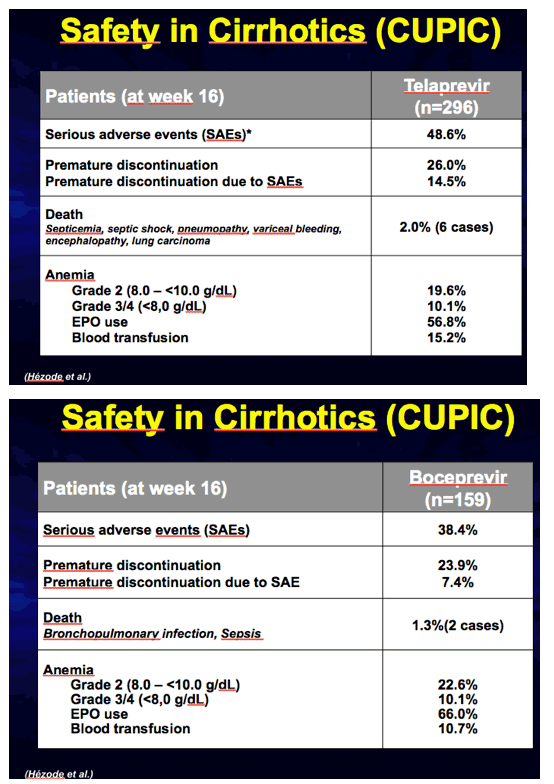 |
 |
 |
| |
Closing Summary by Jean-Michel Pawlotsky Part 3: New data on telaprevir & boceprevir, post-transplant telaprevir/boceprevir treatment in patients with severe recurrence
|
| |
| |
EASL 2012 Sunday Morning Apr 22 Barcelona Spain
From Jules: I added the Program Abstract just below slides which include author & contact info.






PROGRAM ABSTRACT
EFFICACY AND SAFETY OF PROTEASE INHIBITORS FOR SEVERE HEPATITIS C RECURRENCE AFTER LIVER TRANSPLANTATION: A FIRST MULTICENTRIC EXPERIENCE
Speaker: Audrey Coilly Author: A. Coilly1,2*, B. Roche1,2,3, D. Botta-Fridlund4, V. Leroy5, P.G. Pageaux6, S.N. Si-Ahmed7, T.M. Antonini1, D. Samuel1,2,3, J.-C. Duclos-Vallee1,2,3 Affiliation: 1Centre Hepato-Biliaire, AP-HP Hopital Paul Brousse, Villejuif, 2Faculte de Medecine, Univ Paris-Sud, Le Kremlin-BicÍtre, 3Unit 785, INSERM, Villejuif, 4Hopital de la Conception, Marseille, 5CHU de Grenoble, Hopital La Tronche, Grenoble, 6Hopital Saint Eloi, Montpellier, 7Hospices Civils de Lyon, Hopital de la Croix Rousse, Lyon, France. *audrey.coilly@pbr.aphp.fr
Protease inhibitors (PI), Boceprevir or Telaprevir, with peg-IFN/RBV results in a great improvement in term of sustained virological response in genotype 1 patients (pts). We describe a first experience of PI for severe HCV recurrence after LT.
Patients: 10 pts, mean age 51 years [34-67], all men, genotype 1, have been treated with PI (Boceprevir n=9, Telaprevir n=1) between February and November 2011. Recipient IL28B genotype was CC for 6 pts (60%). Mean time between LT and PI was 26 months [3-105]. 6 patients (60%) used Cyclosporine, 4 (40%) Tacrolimus. Indication of therapy was cirrhosis in 4 patients (40%), cholestatic hepatitis in 5 (50%) and 1 (10%) severe acute hepatitis after retransplantation. Response to previous courses of standard therapy was : 3 relapsers (30%), 3 partial non-responders (NR) (30%) and 4 nul NR (40%).
Results: Median follow up was 12 weeks (W) [4-24]. Peg-IFN 2b/RBV dosages ranged between 1 and 1.5 mg/kg/W and 600 to 1200 mg bid. Telaprevir 750mg tid and Boceprevir 800mg tid were initiated at W0 and W4, respectively. At Baseline HCV viral load (HCVL), mean ALT and hemoglobin level were 7.1 ± 0.75 log10 IU/mL [6.3-8.5], 204 ± 247.4 IU/L [40-800], 12.2 ± 1.7 g/dL [8.7-14.9]. At W4 and W8, decrease HCVL was 1.54 ± 1.02 log10 IU/mL [0.2-6.3] and 3.3 ± 2.32 log10 IU/mL [0.7-6.6]. At W12, 3 patients (3/7, 43%) had an undetectable HCVL, 3 patients (3/7, 43%) stopped prematurely therapy for a null response. 1 patient (1/7, 14%) HCVL was < 2 log10 and achieved a complete virological response at W24. Mean decrease HCVL at W12 was 4.2 ± 2.69 log10 [0.7-7]. All patients required EPO (two injections/W for 3 patients (30%)) and 5 patients (50%) required G-CSF because of severe anemia and/or neutropenia. Peg-IFN/RBV were reduced from 25 to 75% in 4 patients (40%). Cyclosporine and Tacrolimus dosages were reduced in 3/6 (50%) and 4/4 (100%) patients.
Conclusions: 57% of patients with severe HCV recurrence after LT had an undetectable viral load at W24 under PI therapy. Interactions between immunosuppression and PI were easily controlled. Final results will be presented.

|
| |
|
 |
 |
|
|